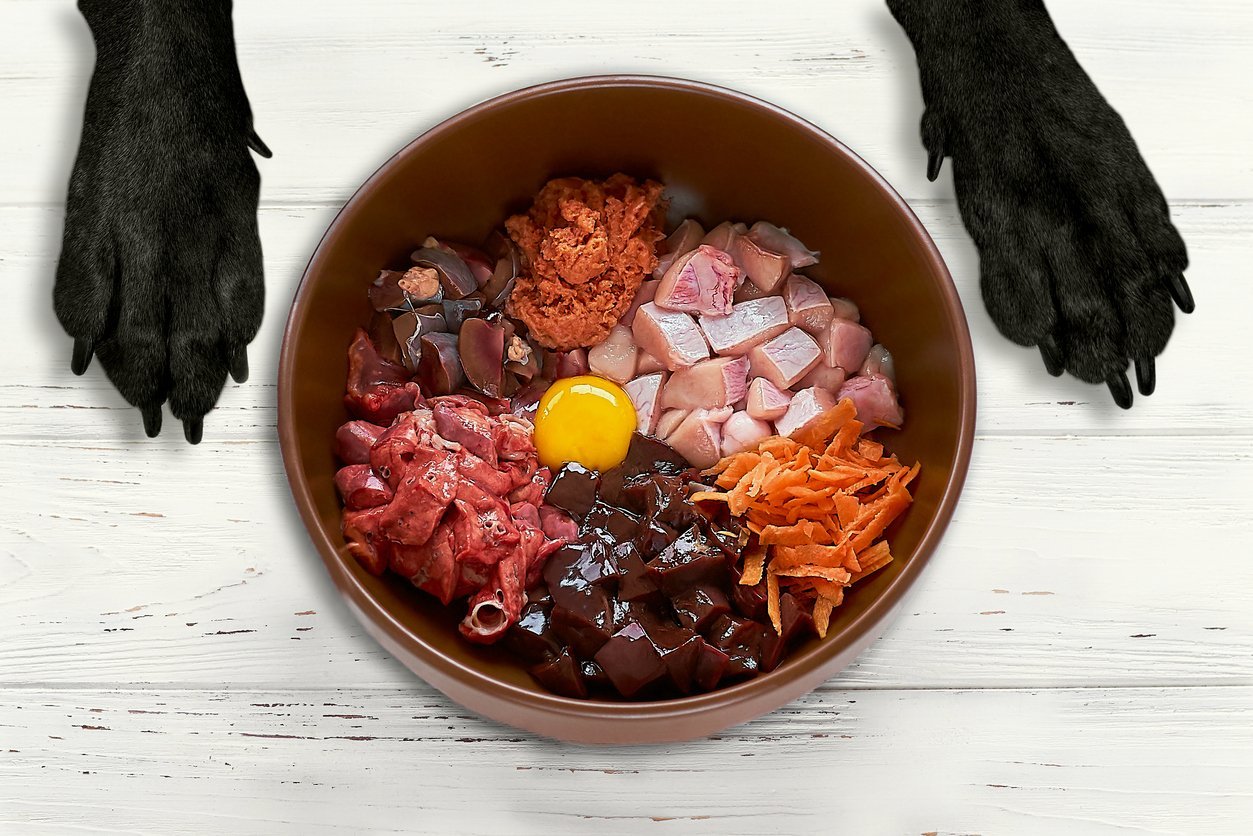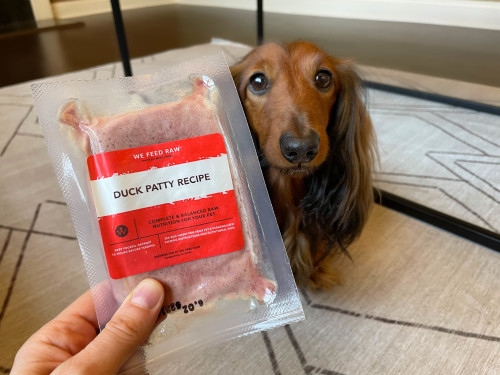A small dog raw food diet consists of uncooked meats, bones, fruits, and vegetables. It’s tailored to mimic a canine’s ancestral eating habits.
Exploring a raw food diet for your small dog could lead to improved vitality and healthier skin. This diet centres around raw ingredients believed to resemble what dogs would naturally consume in the wild closely. Owners opting for this diet often report shinier coats and higher energy levels in their pets.
Balancing the diet is crucial to ensure your furry friend gets all the necessary nutrients. Consulting with a veterinarian before switching is key, as small breeds have specific dietary needs. A well-designed raw food plan can potentially reduce allergies and digestive issues, offering a holistic approach to your small dog’s health. Remember, a safe transition is paramount to avoid gastrointestinal upset.
Credit: resources.integricare.ca
Introduction To Raw Feeding
Raw feeding is a gaining popularity diet trend for small dogs. This diet mimics a canine’s natural eating habits before domestication. It often includes raw meat, bones, fruits, and vegetables. Many pet owners report seeing positive dog changes after switching to raw food. These changes include better coat health, higher energy levels, and improved digestion.
Benefits Of Raw Diets For Small Dogs
Small dogs have specific dietary needs that raw diets can meet. Raw diets are packed with natural enzymes and nutrients. These are often lost during the cooking process of commercial foods. Here is a brief overview of the advantages:
- Improved Dental Health: Chewing raw bones cleans teeth naturally.
- Enhanced Energy: Nutrient-rich meals boost stamina and vitality.
- Healthier Skin: Omega fatty acids in raw food promote a shiny coat.
- Better Digestion: Raw food is easier for small dogs to digest.
- Weight Control: Balanced raw meals help maintain a healthy weight.
Transitioning From Commercial To Raw Food
Switching your small dog to a raw diet should be gradual. Start by mixing raw food with their current diet. Increase the raw portion over time. Observe your dog’s reaction to the new diet. Some dogs may need a few weeks to adapt, while others transition quickly. Here’s a simple transition plan:
| Week | Commercial Food | Raw Food |
|---|---|---|
| 1-2 | 75% | 25% |
| 3-4 | 50% | 50% |
| 5-6 | 25% | 75% |
| 7+ | 0% | 100% |
Always consult a vet before changing your dog’s diet. A vet can provide personalized advice based on your dog’s health needs.

Credit: blog.homesalive.ca
Key Components Of A Raw Diet
Understanding the key components of a raw diet is crucial for small dog health. This diet includes proteins, fats, vitamins, and minerals. Let’s dive into what each of these components offers your furry friend.
Proteins: The Building Blocks
Proteins are essential for muscle growth and repair in small dogs. These nutrients come from animal sources like beef, chicken, and fish. A raw diet for small dogs should include a variety of proteins to ensure they get all the amino acids they need.
The Role Of Fats
Fats provide energy and keep your dog’s coat shiny. Healthy fats are found in raw meats, eggs, and oils. They help in brain development and reduce inflammation. Make sure your small dog gets enough but not too much fat.
Vitamins And Minerals Essentials
Vitamins and minerals support overall health in small dogs. Their bodies need a balance of both to function properly. Raw diets often include fruits and vegetables to meet these needs. Calcium and phosphorus are especially crucial for healthy bones.
| Nutrient | Sources | Benefits |
|---|---|---|
| Protein | Meat, fish, eggs | Muscle development |
| Fats | Meat, oils, eggs | Energy, coat health |
| Vitamins/Minerals | Fruits, vegetables | Overall wellness |

Balancing The Raw Diet
Balancing the Raw Diet for small dogs is crucial. It ensures they get all the necessary nutrients, and a well-planned diet supports their health and energy levels.
Proportion Guidelines
A balanced raw diet typically includes:
- 70% muscle meat – Provides protein and essential nutrients.
- 10% bone – Offers calcium and phosphorus.
- 10% organs – Rich in vitamins and minerals.
- 10% vegetables and fruits – Supplies fiber and antioxidants.
Variety For Nutritional Completeness
Introducing a variety of foods prevents nutritional gaps. Rotate these foods weekly:
| Food Type | Examples |
|---|---|
| Meat | Chicken, beef, lamb |
| Organs | Liver, kidneys, heart |
| Bones | Necks, ribs, marrow bones |
| Veggies | Broccoli, spinach, carrots |
Raw Diet Safety Measures
When feeding your small dog a raw food diet, safety is crucial. While a raw diet can offer many health benefits, it also has potential risks. Understanding and implementing safety measures can prevent health issues. Let’s explore how to handle a raw diet safely for your furry friend.
Addressing Bacterial Concerns
Raw food can harbor bacteria like Salmonella and E. coli, making dogs and humans sick. To minimize this risk, choose high-quality, fresh raw meats. Always source meats from reputable suppliers. Feed your dog as soon as possible after purchase, which reduces bacteria growth.
- Freeze raw meat immediately if not used within a day.
- Thaw meat in the fridge, not at room temperature.
- Discard any leftovers that sit out for more than an hour.
Proper Food Handling And Storage
Storing and handling raw dog food correctly is essential. This keeps the food safe for your dog to eat. It also protects your family from germs.
| Handling Step | Safety Tip |
|---|---|
| Preparation | Use separate utensils and cutting boards for dog food. |
| Storage | Keep raw dog food in sealed containers. |
| Cleaning | Clean all surfaces after food prep with hot, soapy water. |
Remember to wash your hands thoroughly before and after handling raw dog food. Apply soap and warm water for a minimum of 20 seconds. This is one of the most effective methods of stopping germs from spreading.
Keep your dog’s eating area clean. Wipe it down after each meal. Always provide fresh water.
Homemade Vs. Commercial Raw Options
There are two main paths to feeding your small dog a raw diet: homemade meals and commercial options. Each has its benefits and challenges. This section will explore both, helping you make an informed decision for your furry friend.
Choosing Pre-made Raw Meals
Many pet owners opt for pre-made raw meals for convenience. These are balanced and formulated by experts. Look for options with high-quality ingredients. Ensure they meet AAFCO guidelines. Here are key points to consider:
- Variety: A range of proteins like chicken, beef, or lamb.
- Quality: Human-grade meats with no fillers or preservatives.
- Convenience: Easy to store and serve, saving you time.
Pre-made meals often come in frozen or freeze-dried forms. Always check the label for feeding instructions.
Creating Your Balanced Recipes
If you prefer making homemade raw meals, balance is key. You’ll need the right mix of proteins, fats, and vitamins. Here’s a basic outline for a balanced recipe:
| Ingredient | Percentage |
|---|---|
| Muscle Meat | 70% |
| Organ Meat | 10% |
| Bone | 10% |
| Fruits and Vegetables | 10% |
Be sure to include calcium and fatty acids. Supplements might be needed to fill nutritional gaps. Consult a vet or a canine nutritionist before starting.
Crafting homemade meals lets you control the quality. It’s perfect for dogs with specific dietary needs. Remember, balance and variety prevent nutritional deficiencies. Research and prepare meals that will keep your small dog healthy and happy.
Supplementation For Small Dogs
Supplementation for Small Dogs is a key aspect of a raw food diet. Small dogs have unique nutritional needs. Supplements can help meet these needs. Not all small dogs require supplements. It depends on their diet and health. A vet can advise on the need for supplements.
When To Supplement
Owners should consider supplements when:
- The diet lacks certain nutrients
- The dog shows signs of deficiencies
- Health conditions exist that affect nutrient absorption
- Life stages like pregnancy or senior years demand more nutrients
Choosing High-quality Supplements
Selecting the right supplements is critical. Look for:
| Feature | Details |
|---|---|
| Ingredients | It should be all-natural, with no artificial additives |
| Brand Reputation | Choose well-known, trusted brands |
| Formulation | Specific to small dogs’ needs |
| Approval | Look for vet endorsements or certifications |
Remember to start with small doses. Watch for any changes in your dog’s health or behavior, and adjust as needed with vet guidance.
Common Myths About Raw Diets
Many pet owners are curious about raw diets for small dogs. There’s a lot of chatter about what these diets do and don’t do. Let’s explore some common myths to set the record straight.
Debunking Raw Diet Misconceptions
Myth 1: “Raw diets are unnatural for dogs.” Dogs evolved from wild ancestors. They thrived on raw food. This diet is close to what they would eat in nature.
Myth 2: “Raw diets cause illnesses.” With proper handling and hygiene, raw diets are safe. Dogs have strong stomach acids that kill bacteria.
Myth 3: “Raw food lacks nutrients.” A well-planned raw diet is rich in nutrients. It often includes meats, bones, organs, and sometimes fruits and vegetables.
Realistic Expectations And Results
Switching to a raw diet can lead to changes. Not all will happen overnight. Here are some realistic outcomes:
- Improved coat health: Many owners notice a shinier coat.
- Better dental health: Chewing raw bones cleans teeth naturally.
- More energy: Dogs may show higher energy levels on this diet.
- Weight management: A raw diet helps maintain a healthy weight.
Remember, results vary with each dog. Consult a vet to tailor the diet to your pet’s needs.
Monitoring Your Small Dog’s Health
Switching to a raw food diet can significantly benefit your small dog. Monitoring their health closely during this transition is crucial to ensure they are adjusting well.
Watching For Positive Changes
Observe your dog for these key improvements:
- Better skin and coat health: Look for a shinier coat and less skin flaking.
- Improved energy levels: Your dog should show more vitality and playfulness.
- Digestive regularity: Expect more consistent and firmer stools.
These changes can signify that the raw diet suits your pet.
When To Consult A Veterinarian
It’s vital to contact your vet if you notice any of these signs:
| Sign | Action Needed |
|---|---|
| Weight loss | Discuss diet adjustments. |
| Lethargy | Check for dietary deficiencies. |
| Vomiting or diarrhoea | Rule out food intolerance. |
Early intervention can prevent health issues.
Success Stories And Testimonials

Many pet parents are turning to a small dog raw food diet. They tell incredible stories, and their dogs are healthier and happier as a result. We’ve compiled a few testimonies and success tales.
These show the real impact of raw diets on small dogs.
Owners Share Their Experiences
- Jackie’s Joyful Journeys: “My Beagle, Jackie, had dull fur and was lazy. We switched to raw food. Now, she’s full of energy. Her coat shines!”
- Tiny Tim’s Transformation: “Tim was always sick. Vets were puzzled. We tried raw food. He’s a new pup. No more sickness!”
- Lily’s Leaps and Bounds: “Lily had bad teeth, and her breath was not fresh. Raw bones in her diet made a big difference. Her teeth are cleaner, and her breath is fresh.”
Before And After: The Impact Of Raw Diets
| Before Raw Diet | After Raw Diet |
|---|---|
| Dull coat | A glossy, thick coat |
| Low energy | High energy |
| Poor dental health | Strong, clean teeth |
| Frequent illnesses | Boosted immunity |
These stories are just the start. Many dogs see big changes. They feel better on a raw diet, and their owners see the joy in their furry friends. It’s a diet worth considering for small dogs.
Credit: www.wefeedraw.com
Best small dog raw food diet
A raw food diet can be an excellent choice for small dogs, providing them with a natural and nutritious meal plan. The best raw food diets for small dogs typically include a balanced mix of raw meats, bones, fruits, vegetables, and organs, ensuring they receive essential nutrients such as proteins, fats, vitamins, and minerals.
Popular raw food options include chicken, turkey, beef, and lamb, often complemented by vegetables like carrots, spinach, and blueberries for added vitamins and antioxidants. Brands like Stella & Chewy’s, Primal Pet Foods, and The Honest Kitchen offer convenient, high-quality raw food products tailored for small breeds.
These diets can promote healthier skin and coats, improved energy levels, and better digestion. It’s essential to consult with a veterinarian before transitioning to a raw food diet to ensure it meets your small dog’s specific dietary needs and health conditions.
Frequently Asked Questions
Is A Raw Diet Good For Small Dogs?
A raw diet can benefit small dogs, promoting shinier coats and improved energy levels. Always consult with a vet to ensure balanced nutrition and safety.
How Do You Feed A Small Dog Raw?
To feed a small dog raw, choose appropriate raw meats, including organ meats, provide finely ground bones, balance with vegetables, and ensure proper portion sizes for the dog’s weight.
Is A Raw Food Diet Good For Chihuahuas?
A raw diet can be risky for Chihuahuas due to potential nutritional imbalances and bacterial contamination. Consult a vet for personalized advice.
Can Small Dog Breeds Eat Raw Meat?
Yes, small dog breeds can eat raw meat if it’s properly sourced and handled. Ensure the meat is fresh and appropriate for canine consumption. Always consult your vet before changing your dog’s diet.
Conclusion
Embarking on a raw food journey for your petite pooch can be transformative. Tailoring their diet to raw essentials may boost vitality and overall health. Remember, each dog is unique; consult a vet before making dietary shifts. Explore the raw food path, and watch your small dog thrive with the right nutritional choices.

I’m a Canada, UAE, US, and UK-based writer and dog expert blogger. I spent over five years learning about dog food and grooming techniques. Additionally, I recommend avoiding and properly treating various physical problems in dogs. I am here to share my knowledge about good dog nutrition and care.

